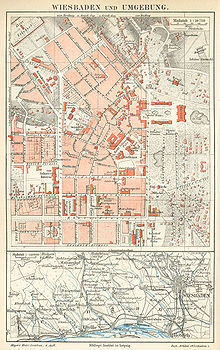Historic pentagon
The historical pentagon denotes the historical core of the Hessian state capital Wiesbaden .
It is bounded in the south by Rheinstrasse , in the west by Schwalbacher Strasse , in the north by Röderstrasse and Taunusstrasse and in the east by Wilhelmstrasse . These streets form a pentagon that encloses Wiesbaden's old town and the Bergkirchenviertel . The development outside this street only began in the second half of the 19th century. Since then, the area has been called the Historical Pentagon .
Within the pentagon is the medieval city plan with many historical buildings, such as the city palace of the Nassau dukes on Schlossplatz , the old town hall , the new town hall and the market church , as well as the oldest preserved building in the city from Roman times, the heath wall , on the western edge . To the north is Kochbrunnenplatz and Kranzplatz. From there, the shopping and pedestrian streets Langgasse and Kirchgasse lead to Rheinstrasse .
The street pentagon goes back to a general development plan from 1818, which the Wiesbaden city builder and architect Christian Zais submitted. Zais' concept encompassed the medieval town center, which was then perceived as unsightly, with streets built on one side in order to hide the inner city.

